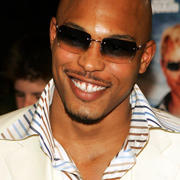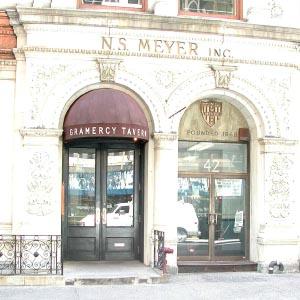 An early publicity photo of Bob Dylan in New York City from his autobiography, Chronicles Volume One.
An early publicity photo of Bob Dylan in New York City from his autobiography, Chronicles Volume One. Goin' to New York City, Gonna find my way
— Bob Dylan, Big City Blues, 1961
There's a bit of a letdown in store when you reach the corner of West 4th and Mercer Streets in Greenwich Village, site of the old Gerde's Folk City club. This is a key stop when walking around Bob Dylan's New York haunts, a collection of spots associated with the singer/bard that mostly lie in the West Village. It was here, back in September, 1961, that Dylan arrived as a musical force.
He was just 19-years-old, wore a goofy black sailor's cap, and resembled, according to New York Times critic Robert Shelton, "a cross between a choir boy and a beatnik."
That night at Gerde's, Dylan worked the piano, guitar and harmonica in an animated set. Shelton noted that: "Mr. Dylan's voice is anything but pretty" and "his clothes may need a bit of tailoring," but nonetheless predicted great things ahead for the newcomer, whom he called "cherubic." Things have changed since the bohemian heyday of Gerde's Folk City. The site of the old club is now an uninspired pile of red bricks.
Walking across nearby Washington Square Park, the mood lifts as you approach the old 18th-century Hangman's Elm on the northwest corner. Musicians still play for free under the giant arch, just like Dylan did four decades ago, and the only apparent change in the park is that drug dealing has been drastically cut. It's now a cheerful family place.
 Peter Edwards Photo
Peter Edwards Photo
Café Wha? in Greenwich Village, where Bob Dylan played after arriving in New York City in 1961.
Kitty-corner to the Hangman's Elm is the old Hotel Earle, now the Washington Square Hotel, at 163 Waverly Place at MacDougal Street, where Dylan lived in room 305 for $19 US a week back in the early '60s. Back then, it had a shabby, artsy elegance and plenty of broke musicians. Nowadays, the clients look like the type of folks who buy art rather than create it and a stay now costs $220 a night (relatively cheap for Manhattan).
Back in the '50s and early '60s, the artsy, largely non-monied, crowd from the Earle also frequented the Cedar Street Tavern, at 24 University Place at 8th Street, a couple of blocks north of Washington Square Park.
Dylan sometimes dropped in on poet Allen Ginsberg and beat writer Jack Kerouac there, but changes here are enough to make you howl. The site of the old Cedar Street Tavern is now a women's clothing store.
A couple of blocks southwest of Washington Square at 115 MacDougal St. at Minetta Lane, is Café Wha?.
It's comforting that the Wha? has weathered the decades in relative style, and a sign outside proudly notes that Dylan and others developed their art here. Dylan played a few Woody Guthrie tunes here before a half-empty house on Jan. 24, 1961. Across the street at 116 MacDougal St., there used to be the Gaslight Café, where, in 1963, Dylan previewed Masters Of War. Upstairs at the Kettle Of Fish bar, musicians, including Dylan, played for whatever donations were tossed into a bucket for them.
Today, the Gaslight and Kettle Of Fish are long gone and the only connection to the 1960s at their former sites are head-shops selling ornate hookah pipes.
Around the corner, off MacDougal on Minetta Lane, there's a Mexican restaurant where The Fat Black Pussycat once stood, and you can still read the old bar's name painted on the laneway's bricks. It was here, back in 1962, where the public first heard Dylan's seminal anti-war ballad, Blowin' In The Wind. Now, the Pussycat enjoys a new life a block away at West 3rd and 6th Avenue, across the street from the jazz hotspot, the Blue Note.
The next stop is 161 West 4th St., where Dylan lived in an apartment with Suze Rotolo in late 1961, after he signed his first record deal. Rotolo's the blond walking arm-in-arm with him on the cover of the 1963 album Freewheelin' Bob Dylan.
By 1975, Dylan was back in the West Village, previewing a new, decidedly non-folk act in front of the inside brick wall at 147 Bleecker St., between LaGuardia Place and Thompson Street at the Bitter End. Here, with his old Hotel Earle hallmate Ramblin' Jack Elliott and Patti Smith, Dylan cooked up the idea of the Rolling Thunder Revue, a travelling troupe of musicians and poets who played small venues with no fanfare or introduction.
The Bitter End is now The Other End and it has a mildly tough, survivor edge to it and a metal plaque outside proclaiming it as Manhattan's oldest surviving rock club. Dylan's image is painted over the bar along with other early End acts like Stevie Wonder and Linda Rondstadt.
Across the street, at 160 Bleecker St., there used to be The Village Gate, where he previewed A Hard Rain's A-Gonna Fall in 1963. The Village Gate's long gone, but if you look way up on the wall of a brick building, you'll see its old sign still painted there.
Hike 25 minutes or so to the White Horse Tavern at 567 Hudson St., a former sailors' and longshoremen's haunt between Perry and West 11th. Poet Dylan Thomas used to enjoy the relaxed atmosphere here in the early 1950s. Dylan changed his name from Robert Zimmerman to Bob Dylan as a tribute to Thomas, and also picked up Irish music at the White Horse.
 Peter Edwards Photo
Peter Edwards Photo
To the right of Birthday Suit is 161 West 4th, where Dylan and girlfriend Suze Rotolo lived in 1961.
There's a Dylan Thomas room in the centre of the White Horse that's perfect for quaffing Original Sin cider from the bottle. The two Dylans missed meeting each other at the White Horse by about eight years. One night in November, 1953, Dylan Thomas set a personal record by downing 18 shots of whiskey. He collapsed on the sidewalk, then was hauled north to the Hotel Chelsea at 222 West 23rd, to sleep it off in his room. He never woke up.
The Chelsea is full of art made by grateful tenants, and its management is clearly proud that it has housed the likes of writer Mark Twain, Eugene O'Neill and Thomas Wolfe. Chelsea owner Stanley Bard, 71, fondly remembers the years Bob Dylan lived here in the 1960s.
Bard smiles when he talks of Dylan, who didn't paint on his walls like Janis Joplin, blare his guitar at night like Jimi Hendrix, have scores of groupies like the Grateful Dead, or find a stabbed body on his bathroom floor, like Sid Vicious of the Sex Pistols.
Much of Dylan's stay at the Chelsea was a sad and introspective time, as his marriage to his first wife Sara was ending.
"He stayed to himself and he was a gentleman," Bard recalls.
For Dylan fans, the Chelsea is best known for the wrenching 1975 song Sara, which chronicles the end of his first marriage with the line, "Stayin' up for days in the Chelsea Hotel, Writin' Sad-Eyed Lady Of The Lowlands For You."
By the time he arrived here, Dylan had come a long way from Gerde's Folk City, and was wildly famous, deeply scarred and anything but cherubic.
Source: Torstar News Service
























